Free implant consultation for a limited period!
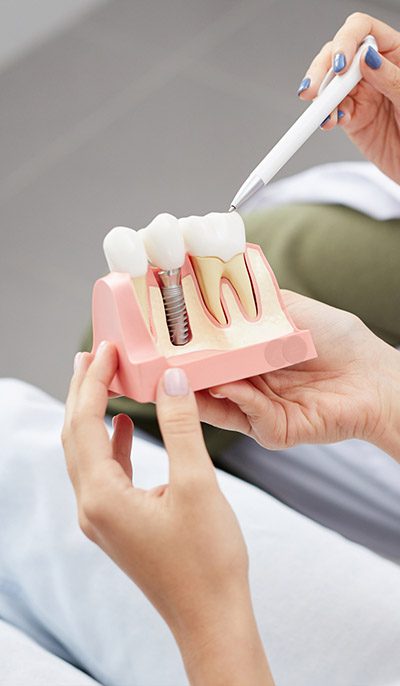




1. First Consultation (40min)
Our expert medical history consultation is key for you. During this initial visit, we assess your overall dental health and discuss potential procedures, including whether a bone graft is necessary. A thorough assessment of your jawbone and gum condition is conducted to ensure they are strong enough to support the dental implant surgery. If any deficiencies are noted, we may discuss options like a bone graft to provide a solid foundation for the implant, which is crucial for supporting the tooth roots.
This consultation also gives us the opportunity to discuss your expectations for the final outcome. We will talk you through the process of selecting the right replacement teeth to suit your needs, and explain how abutment placement connects the implant to your new artificial tooth. Understanding these steps ensures you know what to expect throughout your treatment, and gives you the chance to ask any questions or raise concerns.
Our team will also evaluate the condition of surrounding tooth or teeth and gums, to ensure that your mouth is in the best possible condition to receive the implant. Should any issues be identified, we’ll advise on necessary treatments, which may include periodontal therapy or tooth extraction, to create the optimal environment for your new replacement teeth.
After the dental implant surgery, it’s common for patients to be advised to eat soft foods during the healing process. In some cases, a temporary denture may be provided while the implant site heals, ensuring that your smile remains intact as you wait for the final artificial tooth.
2. Cone Beam CT Scan
The next stage involves a Cone Beam CT Scan. This detailed 3D imaging allows us to plan your surgery accurately, particularly where bone grafts may have been used. The scan helps us to precisely position the replacement tooth for the most natural result.
This advanced imaging technique provides a comprehensive view of your oral structure, including bone density and nerve locations, which is critical for avoiding complications during surgery. It also allows us to plan for the exact placement of the implant, ensuring it aligns perfectly with your bite and the surrounding teeth. This precise planning stage is particularly crucial for patients requiring multiple implants or complex cases where bone density may be compromised.
In cases where a bone graft has been performed, the CT scan helps us assess the success of the graft, ensuring that there is enough bone material to securely hold the implant. This step is vital for the long-term success of the implant, as it directly affects how well the implant will integrate with your jawbone.
3. Impression Visit (10min)
Moulds are taken of your teeth so that a surgical guide or stent can be made.
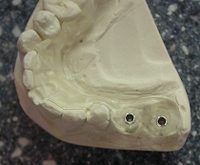


During this visit, we take precise impressions to craft your replacement tooth. If you’ve had a bone graft or other preparatory procedures, this visit is crucial to ensure everything is healing well before we move forward with implant placement.
The impressions taken during this visit are used to create a detailed model of your teeth and gums, which will guide the fabrication of your replacement tooth.
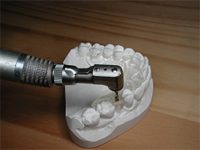


This model helps ensure that the new tooth will fit seamlessly with your natural teeth, providing a comfortable and aesthetically pleasing result.
For patients who have undergone a bone graft, this visit also allows us to check on the healing process and make any necessary adjustments to our treatment plan. We may take additional scans or X-rays to ensure that the bone is developing as expected and that the area is ready for implant placement.
4. Implantation Procedure
Your implant will be surgically placed during this visit. This involves attaching the implant into your jawbone, and, if necessary, securing it with a bone graft to ensure long-term stability. Once the implant has been inserted, a temporary cap may be placed until the abutment placement can occur.
This procedure is performed under local anaesthesia, and our team takes every measure to ensure your comfort throughout the surgery. The implant, made of titanium, is carefully positioned in the bone, where it will act as the root for your new replacement tooth. In cases where bone quality is a concern, a bone graft may be used to provide additional support, ensuring that the implant remains securely in place as it integrates with the bone.
Post-surgery, it is normal to experience some swelling and discomfort, which can be managed with prescribed medication. Our team will provide detailed aftercare instructions, including how to care for the implant site and what to expect during the healing process. This healing period is crucial, as it allows the implant to fuse with the bone, creating a strong foundation for the replacement tooth.
Fusion Period
This is the time taken for the adjacent bone to fuse or bond to the dental implant (osseo-integration). The healing time is usually 8 weeks, but in a minority of cases, it can take up to 4 months. We use a painless radio-wave technique to test that the implant has healed before fitting teeth on any implant. The device we use (Osstell mentor™) gives a reading of implant ‘grip’ onto the bone (Implant Stability Quotient or ISQ). An ISQ value of 60% is usually what we like to get before we start to restore an implant. This period is crucial as the bone must properly support the implant to ensure long-term stability and functionality.
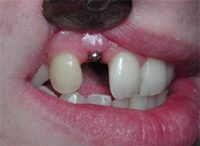


5. Uncovering the Implant (Implant Exposure)
After the initial healing phase, we’ll uncover the implant to prepare for abutment placement. This stage involves minor surgery where the implant is exposed, and the abutment is attached to the implant, forming the base for your new replacement tooth.
This step is essential to transition from the healing phase to the final stages of your treatment. The abutment acts as the connector between the implant and the replacement tooth, ensuring that the new tooth is securely attached to the implant. The minor surgical procedure to uncover the implant is typically quick and performed under local anaesthesia.
Once the abutment is in place, a temporary crown may be fitted while the final replacement tooth is being crafted. This temporary solution allows you to begin using the implant as part of your normal oral function while the permanent crown or bridge is prepared.
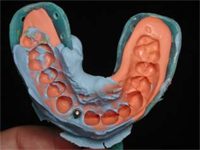


6. Impression of the Abutment
Once the abutment is attached to the implant, a new impression is taken to craft your final replacement tooth. This ensures that the crown or bridge fits perfectly over the abutment.
This impression is critical in achieving a precise fit for your replacement tooth. The goal is to ensure that the crown or bridge not only fits securely but also matches the shape, size, and colour of your natural teeth. This attention to detail is what ensures the final result is both functional and aesthetically pleasing.
Our technicians use the latest digital technology to create a highly accurate model of the abutment and surrounding teeth, which guides the fabrication of your permanent crown or bridge. This process takes into account the alignment of your bite, ensuring that the new tooth integrates seamlessly with your existing teeth.
7. Visit the Dental Technician for Cosmetic Matching of Your Teeth
Your next visit might involve a session with our dental technician, who will match the colour of your replacement tooth to your natural teeth, ensuring a seamless blend.
This step is crucial for achieving the most natural-looking result. The technician will assess the shade and translucency of your natural teeth to craft a replacement tooth that is indistinguishable from the rest of your smile. We understand that the appearance of your teeth is just as important as their function, and we strive to provide results that meet your aesthetic expectations.



8. Fabrication of the Crown by our Dental Technicians
It typically takes 2-3 weeks for our technicians to craft the replacement tooth. During this time, we ensure that the abutment is properly attached to the implant and that all aspects of the fit and colour are checked.
Our technicians work closely with your dentist to ensure that the final replacement tooth meets all the necessary specifications. This collaboration is key to achieving a result that not only looks great but also functions perfectly within your bite. The materials used in crafting your new tooth are selected for their durability and aesthetic quality, ensuring that your replacement tooth will last for many years to come.
9. Fitting of the Crown or Bridge: (30 minute appointment)
At this stage, the crown or bridge, which is your replacement tooth, is secured to the abutment attached to the implant. This process completes your dental implant procedure, giving you a fully functional and aesthetically pleasing new tooth.
The final fitting is an exciting step in your dental implant journey, as it marks the completion of the process. Your dentist will carefully place the crown or bridge, ensuring that it fits snugly over the abutment and that your bite is correctly aligned. Any necessary adjustments will be made to ensure that your new tooth feels comfortable and functions perfectly.
Once the replacement tooth is in place, we will provide you with detailed care instructions to ensure the longevity of your implant. With proper care, your new tooth can last a lifetime, providing you with the confidence and comfort that comes with a complete, healthy smile.
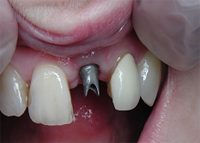



Post fitted to implant
If you are not sure we will fit the crown with light cement and you can wear the crowns for a few weeks to see how they look in different lighting.
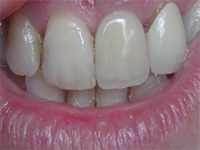


Minor adjustments of crowns and bridges can be made at the chair side. If a substantial change is needed, the work would be returned to the dental technician for adjustment. Be reassured that we will not fit the work unless you are pleased with how it looks and feels.
We take great pride in knowing that none of the patients we have treated in the last 20 years have been dissatisfied with the cosmetic results achieved. We feel this reflects our dedication and efficiency in our implant work.




10. Post Fitting Review Appointment (20 minutes)
A follow-up appointment is scheduled to check the integration of your replacement tooth with the implant and to ensure everything is functioning as expected. We also assess the healing of any areas where bone grafts were placed.
This review is a crucial part of the process, allowing us to monitor the success of the implant and address any issues early on. We will check that the replacement tooth is securely attached to the implant and that there are no signs of complications. If a bone graft was used, we will also examine the graft site to ensure that it has fully integrated with the surrounding bone.
During this appointment, you’ll have the opportunity to discuss any concerns or questions you may have about your new replacement tooth. Our goal is to ensure that you are completely satisfied with the result and that your implant functions as intended.
Important Notes on Implant Care:
- Post-implant care is essential, especially if you’ve had a bone graft.
- Regular follow-ups ensure the abutment remains securely attached to the implant and that your replacement tooth is in excellent condition.
- It is vital to maintain good oral hygiene practices to prevent any complications around the implant site, including brushing and flossing regularly.
Avoid hard or sticky foods that could potentially damage the replacement tooth or disrupt the integration of the implant.
Address
Dr P Young BDS PhD specialist in oral surgery
29 Castle Street, Northwich, Cheshire, CW8 1BA
Tel / Fax Reception Staff
Copyright Oral Implants Ltd. All rights reserved. Website by Carrie-ann Sudlow - Privacy Statement
